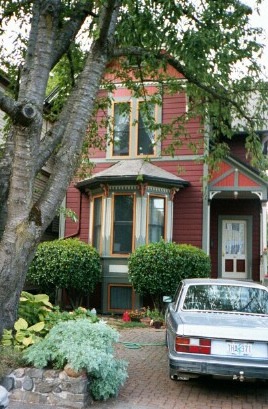Unless congress extends the deadline, 2010 is the last tax year that you can take a federal income tax credit for replacing doors and windows with new energy-efficient ones, or adding storms to existing windows. However, before taking that big (and potentially expensive) step:
- Consider an energy audit to determine just how bad your windows and doors are.
- Then compare the overall cost of replacement, with that of repair and maintenance.
If you have an older home (built prior to 1960), repairing and retrofitting existing doors and windows with storms might be a better tax-deductible option than tearing them out and replacing with new aluminum, vinyl or clad windows. Not just for immediate cost reduction, but for a better maintenance cost reduction going forward.
When I lived in Oregon, I bought a 120 year old Victorian home, with almost all the original doors, windows and ornamentation in-tact. Prior to the new paint, I had all the original wood-sash windows repaired, and added removable wood storms for winter/screens for summer. This allowed me to improve its energy efficiency, while still retaining the historic look and quality of the home, as long as I maintained the finish on the wood properly (see photo above).
My family home here in Bigfork is 60 years old and still has all its original wood sash windows with aluminum storms/screen. All are in excellent working order, keeping cold drafts out. Over the years, only the glass of one window has needed to be replaced; apart from that, the only maintenance I’ve had to do is repaint the sashes every few years, and keep the glass clean.
Adding Storms to Existing Windows/Doors vs Replacement Windows/Doors
The National Trust for Historic Preservation provides the following arguments for adding storms and repairing original windows, rather than replacing with new windows. From a recent NTHP newsletter, these arguments are all about sustainability:
Are new windows truly ‘green’?
“Tearing out historic windows for replacements waste embodied energy – the energy required to extract the raw materials, transport them, make them into a new product, ship the product and install it. What’s more, when we keep our existing windows, we avoid all the negative environmental impacts associated with the manufacture of new windows. For example, the making of some windows produces toxic byproducts.”
Window lifespan
“New windows will often have a life-span of just 10 to 20 years. Traditional wood windows, if properly maintained, can last for many more decades. [Indeed, my Victorian windows were still functional after 120 years].
Furthermore, with proper weatherization of a wood window, and use of a good storm window, older windows can be made nearly as energy efficient as new windows – even in severe climates.”
Window performance
“While it’s true that not every old window can be saved, with routine maintenance, and with the installation of storm windows, an older window can perform well and continue to function for years and years.”
Are replacement windows actually maintenance-free?
“Vinyl, aluminum, fiberglass, and composite windows are manufactured as a unit and are maintenance-free ONLY because the components cannot be repaired. When a part fails, or the insulated glass seal breaks, the entire unit must be replaced. By comparison, older wood windows are composed of interlocking parts made from natural materials, and any part can be repaired or replaced.”
[Thus, maintaining older windows costs far less than ‘maintenance’ of new windows, over the long haul.]
Will new windows really save you money?
“Window manufacturers are quick to tell you that their products will save you money. While replacement windows could save you about $50 a month on your heating or cooling bills, those savings come after you spend $12,000, on average, for replacement windows for the typical home. So if you heat or cool your home, say, six months a year, the savings are about $300 annually. At that rate, it would take 40 years to recoup in energy savings the amount of money spent on the new windows!”
[NOTE: The cost savings estimate is based on average cost of electricity nationwide. Our rates in the Flathead are less, so the energy savings will be less. On the other hand, the cost of new windows is fairly consistent around the country. Thus it could take more than 40 years to recoup your costs here].
Quality
“Old windows are built with high-quality materials, such as old-growth wood. What’s more, historic windows were made to fit a specific opening, then custom-installed. True, over time older windows may shift and change, yet they still securely fit their openings. [By contrast,] when stock replacement windows are installed in historic openings, there is no guarantee that they will fit well. If they don’t fit, the resulting gaps around the windows could be MORE drafty than the historic windows that were removed (especially if the older windows were augmented with storm windows).”
For more information
About the Federal tax credit
- Consumer Energy Tax Incentives (US Dept. of Energy)
- Federal Tax Credits for Consumer Energy Efficiency (from Energy Star)
- IRS Form 5695: Residential Energy Credits
From the National Trust for Historic Preservation
- National Trust for Historic Preservation Home Page
- About the proposed Home Star program (“Cash for Caulkers”)
- Home Star: What does the bill mean?
- Windows & Weatherization
- Why do my old windows matter?
- Should I believe the hype about new windows being better?
- Should I repair or replace my old windows?
- Will storm windows help?
- How do I find someone to repair my windows?
- Are there easy, low-cost ways to make my windows more energy efficient?
- National Windows Campaign (will add link when available)
